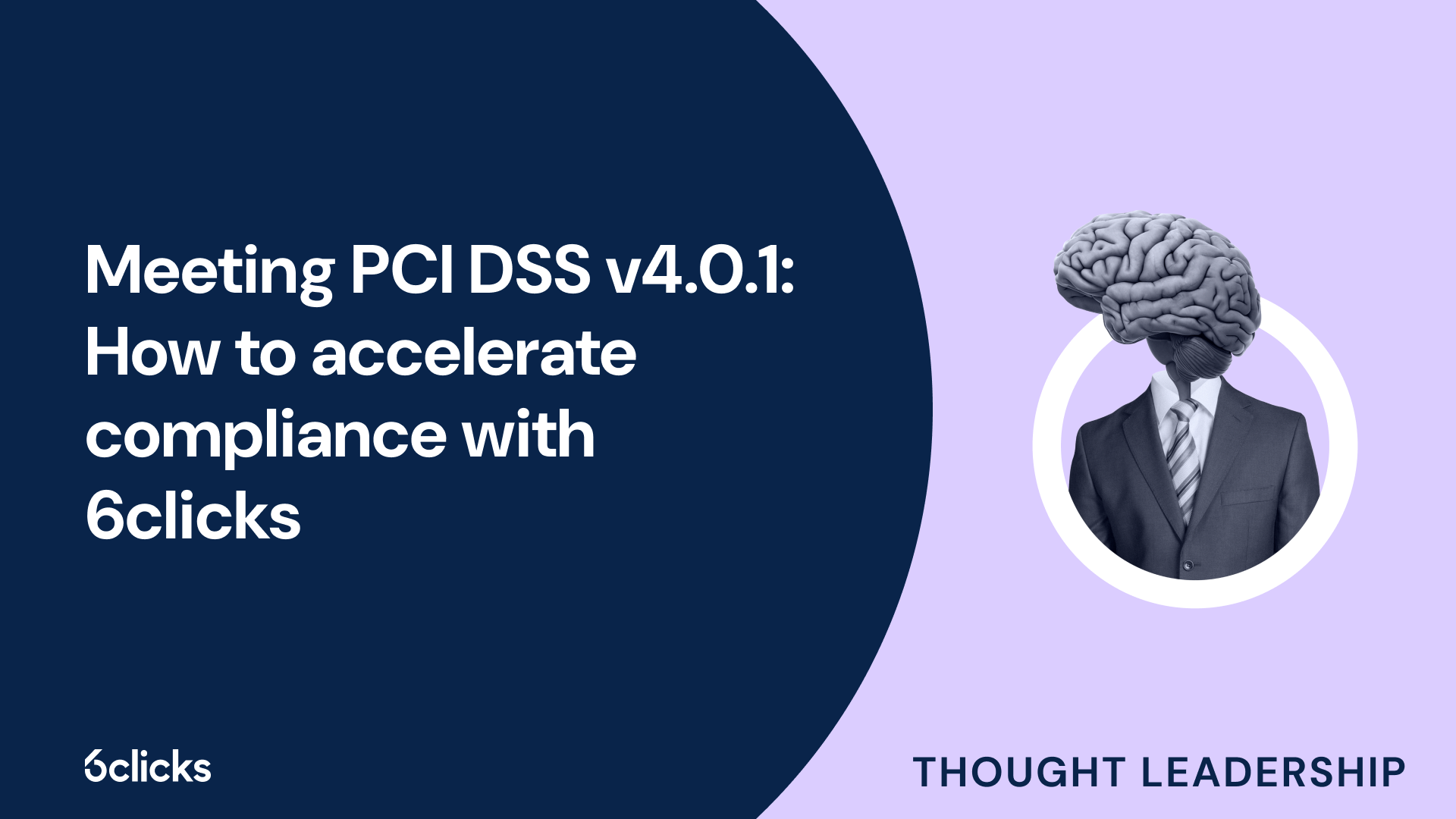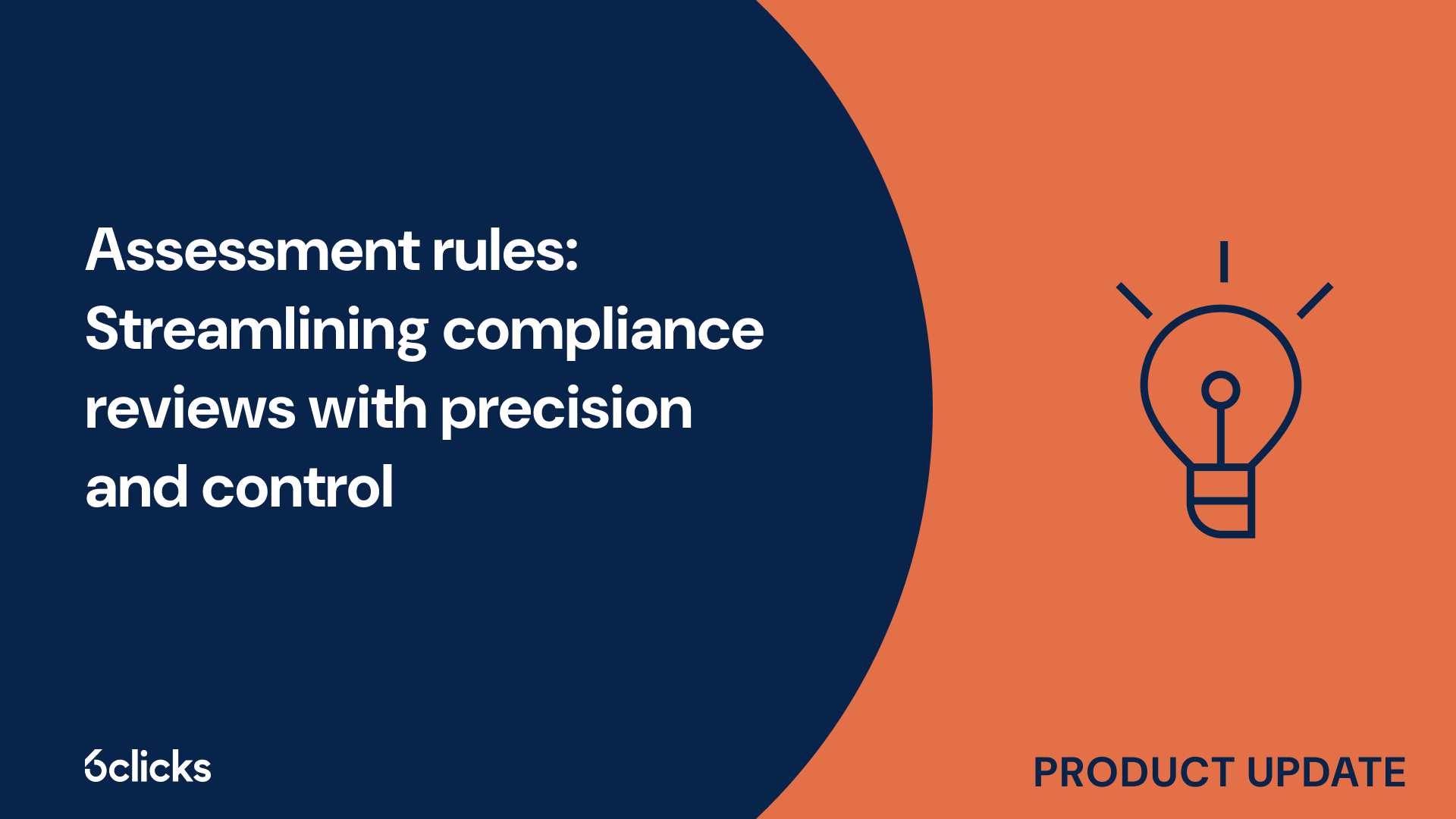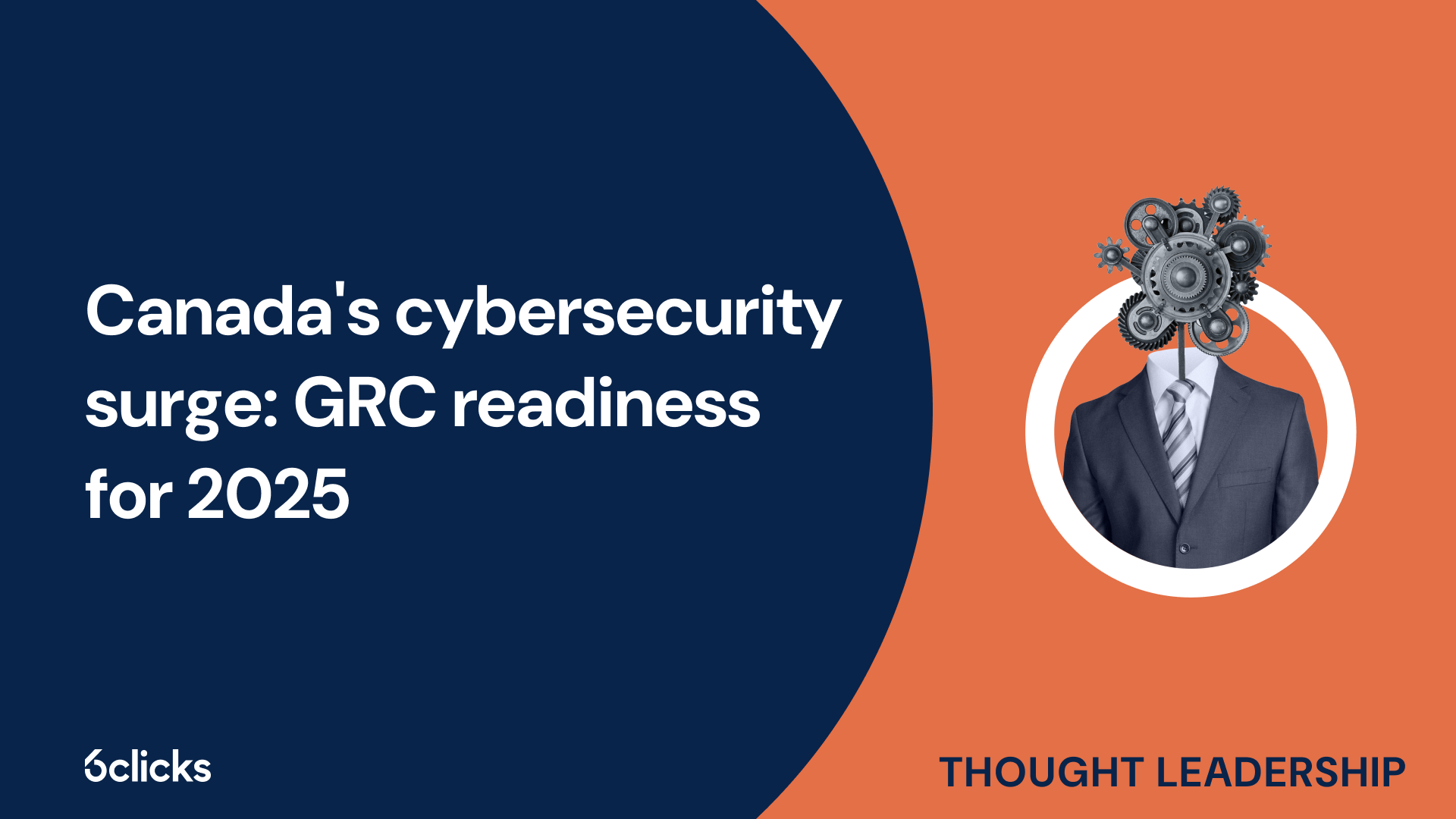Cyber Risk Management Expert Guide
Master cyber risk management with our expert guide! Learn how to identify, evaluate, and address cybersecurity threats using ISO 31000 principles. Access a turn-key cyber risk library and discover how to streamline risk assessments. Download now!
-1.png?width=200&height=249&name=Group%20193%20(1)-1.png)
Cyber Risk Management Expert Guide
What is the cybersecurity lifecycle?
The cybersecurity lifecycle refers to the continuous process of managing and protecting an organization's information systems and data from cyber threats. It involves the identification, protection, detection, response, and recovery stages to ensure effective cybersecurity measures. This holistic approach enables organizations to proactively assess and address potential risks and vulnerabilities, as well as respond and recover from cyber incidents. By understanding the cybersecurity lifecycle, organizations can develop a robust security posture, implement effective security measures, and mitigate the impact of cyber threats.
Why should i care about the cybersecurity lifecycle?
The cybersecurity lifecycle is a crucial framework that outlines the stages involved in protecting against cyber threats. It provides a structured and systematic approach to managing security measures and maintaining a strong security posture.
One key reason to care about the cybersecurity lifecycle is that it ensures a continuous and proactive approach to cybersecurity. In today's rapidly evolving threat landscape, cyber threats are constantly evolving, making it essential to have a dynamic and adaptable security strategy. By following the cybersecurity lifecycle, organizations and individuals can stay updated on the latest threats and implement effective preventive and responsive measures.
Another reason to prioritize the cybersecurity lifecycle is that it helps set and maintain security standards. By following the defined stages of the lifecycle, security teams can ensure that security management, risk assessment, incident response, and recovery strategies are consistently upheld. This promotes a culture of security awareness and accountability throughout the organization, reducing the likelihood of security breaches and vulnerabilities.
Ultimately, caring about the cybersecurity lifecycle enables organizations and individuals to proactively mitigate cybersecurity risks and protect critical assets. By embracing a continuous process that includes threat intelligence, security operations, incident response, and recovery activities, they can effectively safeguard against potential threats and minimize the impact of future incidents.
Stage 1: risk management
The first stage of the cybersecurity lifecycle is risk management, which involves identifying and assessing potential cybersecurity risks to an organization's systems, networks, and data. This stage is crucial as it sets the foundation for the entire lifecycle by understanding the unique risks and vulnerabilities that could impact the organization. During this stage, security professionals conduct comprehensive risk assessments to identify potential threats, assess the potential impact of those threats, and determine the likelihood of them occurring. This information helps organizations prioritize their security efforts and allocate resources accordingly. Risk management also includes establishing risk mitigation strategies and implementing security measures to reduce the likelihood or impact of potential threats. This stage plays a vital role in shaping the overall security posture of an organization, ensuring proactive measures are in place to address potential vulnerabilities and protect against cyber threats. By effectively managing risks, organizations can significantly enhance their security resilience and mitigate potential damages caused by future incidents.
Identifying risks
In the cybersecurity lifecycle, identifying risks is a crucial step in developing an effective security strategy. By assessing the security risk and identifying valuable cyber assets, organizations can proactively protect their sensitive information from potential threats.
To begin, organizations should conduct a comprehensive assessment of their security risk. This involves evaluating the potential threats and vulnerabilities that exist within their network infrastructure and systems. By understanding these risks, organizations can prioritize their security measures and allocate resources accordingly.
Next, implementing data classification policies is essential for identifying and protecting valuable cyber assets. Data classification categorizes information based on its sensitivity and importance, enabling organizations to apply appropriate security controls and track access to critical data.
In addition to data classification, organizations should inventory their IT assets to track vulnerabilities effectively. This involves creating a comprehensive list of all software and hardware assets, including servers, network devices, and endpoints. By assessing the vulnerabilities associated with each asset, organizations can prioritize security patches and updates to mitigate potential risks.
Lastly, it is crucial for organizations to consider all available options before deciding on the best course of action to address identified risks. This may involve implementing additional security measures, such as network segmentation, access controls, or encryption, to safeguard valuable cyber assets.
Assessing risks
Assessing risks is a critical step in the cybersecurity lifecycle that helps organizations identify and prioritize potential threats and vulnerabilities. This process involves evaluating valuable cyber assets and implementing data classification policies.
Firstly, organizations need to identify their valuable cyber assets by classifying their data based on its sensitivity and importance. This can be achieved through data classification policies that categorize information into different levels such as public, private, and restricted. By doing so, organizations can determine the level of protection each piece of data requires and track and organize users' access accordingly.
Secondly, organizations should inventory their IT assets using IT asset management software. This allows them to accurately track and manage their hardware and software assets, including servers, network devices, and endpoints. By regularly updating this inventory, organizations can identify vulnerabilities and systems that need upgrades or replacement to mitigate potential risks.
By assessing risks through the evaluation of valuable cyber assets and the implementation of data classification policies, organizations can gain a better understanding of the threats they face and take appropriate measures to safeguard their sensitive information and systems.
Prioritizing risks
Prioritizing risks is a crucial step in the cybersecurity lifecycle, as it helps organizations allocate their resources effectively to address the most critical threats. To prioritize risks, organizations need to follow a systematic process that includes assessing the value of assets, determining their threat exposure, conducting investigation and research, and adding threat context to the report.
Firstly, organizations need to assign a value to each asset based on its criticality to the business. This can be done by considering factors such as the asset's importance in supporting operations, its financial value, and its sensitivity. By assigning a value, organizations can identify high-value assets that require more attention and protection.
Next, organizations should gauge the threat exposure of each asset through investigation and research. This involves conducting vulnerability assessments, penetration testing, and analyzing threat intelligence to identify potential vulnerabilities and the likelihood of successful attacks. This information helps organizations understand the level of risk associated with each asset.
Furthermore, organizations should communicate with their security operations team and utilize endpoint security tools to gather threat context. By sharing information and collaborating with security professionals, organizations can gain insights into emerging threats, known attack vectors, and indicators of compromise. Endpoint security tools can provide real-time information on the behavior of threats and help prioritize risks based on their potential impact.
Developing a risk mitigation plan
Developing a risk mitigation plan is a critical step towards ensuring a strong cybersecurity posture for any organization. This plan helps identify and assess risks, determine the most vulnerable areas of the system, and prioritize actions to minimize potential impacts. By systematically addressing vulnerabilities, organizations can effectively manage and mitigate cybersecurity risks.
The first step in developing a risk mitigation plan is identifying risks. This involves conducting a comprehensive assessment of the organization's assets, infrastructure, and processes to determine potential vulnerabilities. This can be done through various methods such as vulnerability scanning, penetration testing, and security audits. By identifying possible risks, organizations can gain a better understanding of their security landscape.
Once risks have been identified, the next step is to assess their potential impact. This includes evaluating the likelihood of threats exploiting vulnerabilities and the potential consequences of a successful attack. By assessing risks, organizations can prioritize actions based on the level of threat they pose to the system and the potential impact on critical operations.
After assessing risks, the next step is to prioritize them. This involves ranking risks based on their potential impact and likelihood of occurrence. By prioritizing risks, organizations can allocate resources and implement appropriate measures to address the most critical vulnerabilities first. This helps maximize the effectiveness of the risk mitigation efforts.
Finally, with a prioritized list of risks, organizations can develop a risk mitigation plan. This plan outlines specific actions and controls that need to be implemented to minimize identified risks. It should include measures such as implementing security controls, enhancing network security, educating employees on cybersecurity best practices, and establishing incident response procedures. Regular monitoring and updating of the plan ensures ongoing protection against evolving threats.
Implementing the plan & monitoring progress
After developing a risk mitigation plan, the next crucial step in the cybersecurity lifecycle is implementing the plan effectively. This involves following the defined policies and procedures to ensure the successful execution of the plan.
To begin with, organizations need to allocate the necessary resources to implement the plan. This includes assigning responsible individuals or teams who will be tasked with carrying out specific actions and controls outlined in the plan. It is important to ensure that these individuals have the required skills and knowledge to effectively implement the plan.
Furthermore, organizations need to establish clear communication channels to ensure effective coordination and collaboration among different stakeholders involved in the implementation process. This includes regular meetings, updates, and documentation to capture progress and address any challenges or roadblocks.
To monitor the progress of the plan, organizations should track key performance indicators (KPIs) related to the identified risks and their corresponding controls. These KPIs may include metrics such as the number of vulnerabilities patched, the percentage of employees who have completed cybersecurity training, or the frequency of security audits conducted.
Regular audits should be conducted to evaluate the effectiveness of the implemented controls and identify any gaps or areas for improvement. These audits can be conducted internally or by third-party firms specializing in cybersecurity assessments.
By following defined policies and procedures, tracking KPIs, and conducting regular audits, organizations can ensure the successful implementation of their risk mitigation plan and continuously monitor progress in the cybersecurity lifecycle. This helps maintain a proactive approach to cybersecurity and strengthens the organization's overall security posture.
Stage 2: security planning & architecture design
In the cybersecurity lifecycle, Stage 2 focuses on security planning and architecture design. This stage involves creating comprehensive security plans and designing a robust architecture that will help organizations protect their valuable assets from cyber threats. During this stage, organizations need to identify and assess their security risks, understand their current security posture, and determine the necessary security measures to be implemented. Additionally, organizations need to develop security policies, procedures, and guidelines, and establish a framework for managing and monitoring security controls. By engaging in thorough security planning and architecture design, organizations can lay a solid foundation for effectively safeguarding their systems, networks, and data while mitigating potential cybersecurity risks.
Developing security requirements and goals
Developing security requirements and goals is a critical aspect of the cybersecurity lifecycle. Organizations must establish a solid foundation for their security posture by effectively identifying, assessing, and addressing potential threats. Here are the key steps involved in this process:
- Identify Assets to Protect: The first step is to identify the assets that need to be protected, such as sensitive data, networks, applications, and systems. This helps determine the scope and focus of security efforts.
- Assess Potential Threats: Once the assets are identified, organizations must assess potential threats and vulnerabilities that could compromise their security. This involves analyzing past incidents, staying informed about emerging cyber threats, and conducting risk assessments.
- Define Security Requirements and Goals: Based on the identified assets and potential threats, organizations need to define their security requirements and goals. This includes establishing guidelines, policies, and procedures that address the specific security needs of the organization.
- Align with Business Objectives: It is essential to align security requirements and goals with the overall business objectives of the organization. This ensures that security measures are not implemented in isolation but are integrated into the business processes to enable smooth operations.
- Integrate Security Measures: Finally, organizations must integrate security measures into existing systems and processes to ensure a holistic approach to cybersecurity. This may involve implementing firewalls, intrusion detection systems, encryption, access controls, and security awareness training.
Designing the security architecture
Designing the security architecture is a crucial step in the cybersecurity lifecycle. It involves developing security requirements and goals, designing a comprehensive security architecture, and integrating security measures into existing systems. This process ensures the protection of various elements in the IT ecosystem, including network security, system security, and data security.
To start, organizations need to develop clear security requirements and goals based on their identified assets and potential threats. This includes determining the level of protection needed for different systems and data, as well as establishing guidelines, policies, and procedures to address specific security needs.
Next, organizations must design a security architecture that aligns with their requirements and goals. This involves selecting and implementing various security measures such as firewalls, intrusion detection systems, encryption, access controls, and security monitoring tools. The architecture should be designed to provide layered defense mechanisms to prevent and detect cyber threats effectively.
Integrating security measures into existing systems is essential to ensure a holistic approach to cybersecurity. This includes configuring security settings, updating software and firmware, and implementing patches to address vulnerabilities. Additionally, organizations should conduct regular security training for employees to educate them on security best practices, promote awareness of potential threats, and prevent insider threats.
Integrating security Into existing systems
Integrating security into existing systems is a crucial aspect of the cybersecurity lifecycle. To successfully accomplish this, organizations need to follow a systematic process that includes developing security requirements and goals, designing a security architecture, and incorporating various security solutions into the IT ecosystem.
The first step in integrating security into existing systems is to identify and define clear security requirements and goals. This involves assessing the organization's assets and potential threats, and determining the level of protection needed for different systems and data. By understanding the specific security needs, organizations can establish guidelines, policies, and procedures to address potential vulnerabilities.
Next, organizations must design a robust security architecture that aligns with their requirements and goals. This includes selecting and implementing various security measures such as firewalls, intrusion detection systems, encryption, access controls, and security monitoring tools. The architecture should be designed to provide layered defense mechanisms to prevent and detect cyber threats effectively.
When integrating security into existing systems, it is essential to consider network security, system security, and data security as key elements to protect. Network security focuses on securing the organization's network infrastructure to prevent unauthorized access and data breaches. System security involves implementing security measures to protect individual devices and endpoints from malicious activities. Data security aims to safeguard sensitive information by implementing encryption, access controls, and data loss prevention measures.
Finally, to ensure a holistic approach to cybersecurity, organizations must continuously monitor and update their security measures. This includes configuring security settings, updating software and firmware, and implementing patches to address vulnerabilities. Regular security training for employees is also crucial to educate them on security best practices, promote awareness of potential threats, and prevent insider threats.
Stage 3: implementation & configuration management
Once the security requirements and goals have been defined and the architecture has been designed, the next stage in the cybersecurity lifecycle is the implementation and configuration management. This stage focuses on putting the security measures into action and ensuring that they are properly configured and integrated with existing systems.
During this stage, organizations need to deploy the selected security measures, such as firewalls, intrusion detection systems, and encryption tools, across their network infrastructure and devices. This includes installing and configuring these tools to accurately monitor and protect the organization's systems and data. Additionally, organizations need to establish proper access controls and user permissions to ensure that only authorized individuals can access sensitive information.
Configuration management plays a vital role in this stage, as it involves maintaining and updating the security measures over time. This includes regularly reviewing and adjusting configurations to address emerging threats, applying security patches and updates, and monitoring for any security vulnerabilities. By effectively managing configurations, organizations can ensure that their security measures remain up-to-date and effective against evolving cyber threats.
Furthermore, organizations should also consider implementing incident response and recovery strategies during this stage. This involves establishing procedures and protocols for quickly identifying, containing, and mitigating any security incidents or breaches. By having an effective incident response plan in place, organizations can minimize the impact of a security incident and swiftly restore normal operations.
Creating policies and procedures
Creating policies and procedures is a critical aspect of cybersecurity implementation and configuration management. These documents outline the guidelines and best practices that organizations need to follow to ensure the effective deployment, configuration, and management of security measures.
Policies provide high-level guidance and establish the overarching principles that govern cybersecurity within an organization. They define the roles and responsibilities of different stakeholders, set the expectations for security practices, and outline the organization's commitment to protecting sensitive data and systems. Procedures, on the other hand, provide detailed step-by-step instructions on how to implement and configure specific security measures.
Creating policies and procedures helps organizations ensure compliance with regulatory frameworks and data protection standards. These frameworks, such as ISO 27001, The Privacy Act, the ASD Essential 8, NIST framework, APRA CPS234, and GDPR, provide guidelines and requirements for organizations to protect their assets and maintain the privacy and security of data.
By aligning their policies and procedures with these frameworks, organizations can demonstrate their commitment to cybersecurity and data protection. It helps them establish a sound security posture, reduce vulnerabilities, and mitigate risks. Compliance with these frameworks also helps organizations build trust with customers, partners, and regulatory bodies.
Installing security software and hardware solutions
Installing security software and hardware solutions is a critical step in establishing a robust cybersecurity infrastructure. This process involves the deployment and configuration of tools and technologies designed to protect against various cyber threats.
The first step in installing security solutions is conducting a thorough risk assessment. This assessment helps identify the potential threats and vulnerabilities faced by an organization's IT ecosystem. By understanding these risks, organizations can select the most appropriate security solutions to address them effectively.
When it comes to protecting an organization's IT ecosystem, there are three key segments to consider: network security, system security, and data security. Network security focuses on safeguarding the organization's network infrastructure from unauthorized access and malicious activities. System security involves securing the various devices and servers within the network, ensuring they are protected from exploits and vulnerabilities. Data security, on the other hand, pertains to the protection of sensitive and confidential data from unauthorized access, theft, or loss.
In addition to implementing security software and hardware solutions, organizations should also prioritize security training for employees. This training helps educate employees about the best practices and preventive measures they can take to mitigate cybersecurity risks. By promoting a culture of cybersecurity awareness, organizations can effectively prevent insider threats and ensure that employees are equipped to recognize and respond to potential security incidents.







